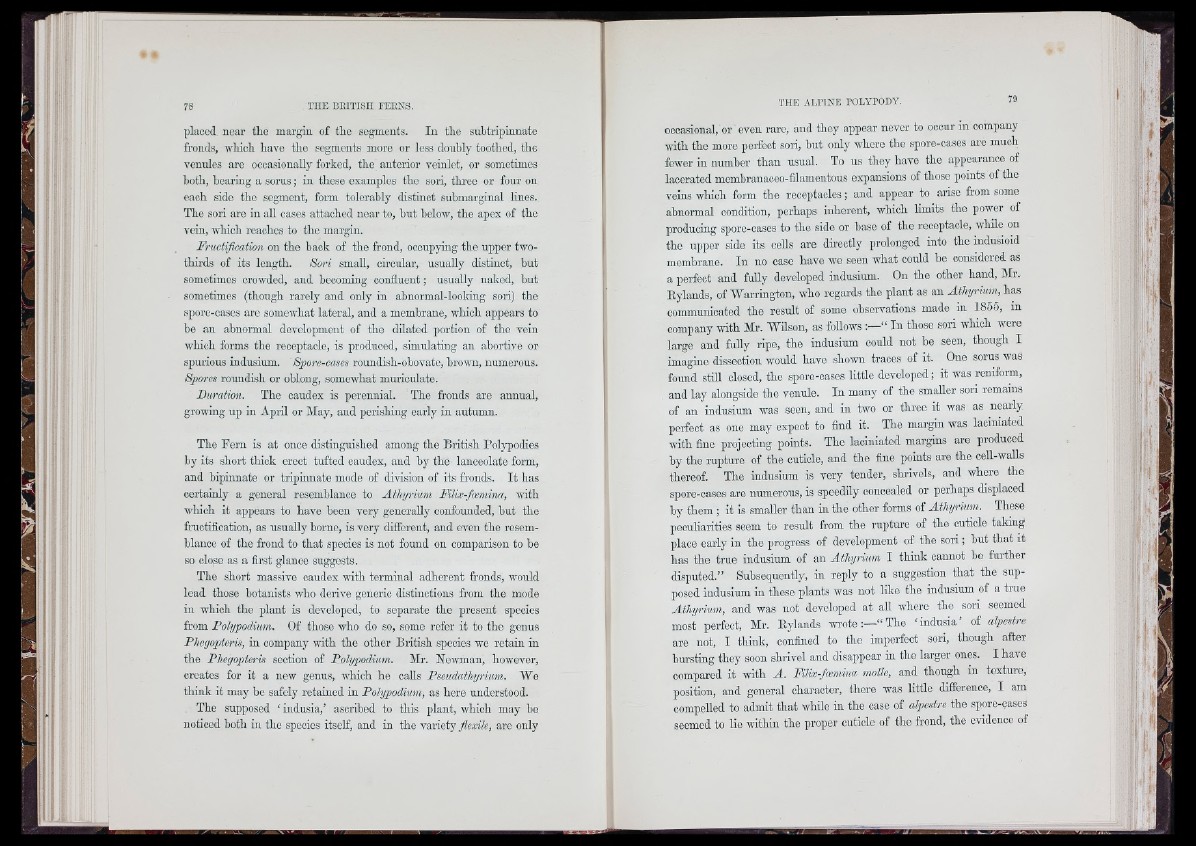
placed near the margin of the segments. In the subtripinnate
fronds, which have the segments more or less doubly toothed, the
venules arc occasionally forked, the anterior voinlot, or sometimes
both, bearing a sorus; in these examples the sori, three or four on
each side the segment, form tolerably distinct suhmarginal lines.
The sori are in all cases attached near to, hut below, the apox of the
vein, which reaches to tho margin.
Fructification on tho back of the frond, occupying tho upper two-
thirds of its length. Sori small, circular, usually distinct, but
sometimes crowded, and boooming confluent; usually naked, but
sometimes (though rarely and only in ahnormal-looking sori) the
spore-cascs aro somewhat lateral, and a membrane, which appears to
ho an abnormal development of the dilated portion of tho vein
wliich forms the reooptaclo, is produced, simulating an abortive or
spurious indusium. Spore-cases roundish-obovato, brown, numerous.
Spores roundish or oblong, somewhat muriculate.
Duration. The caudex is perennial. The fronds arc annual,
growing up in April or May, and perishing early in autumn.
Tho Fern is at once distinguished among the British Polypodies
by its short thick erect tufted caudex, and by the lanceolate form,
and bipinnate or tripinnate mode of division of its fronds. I t has
certainly a general resemblance to Athyrium Filix-foemina, v ith
which it appears to have been very generally confounded, hut the
fructification, as usually homo, is very different, and even the resemblance
of the frond to th a t species is not found on comparison to ho
so close as a first glance suggests.
Tho short massive caudex with terminal adherent fronds, would
lead those botanists who derive generic distinctions from the mode
in which the plant is developed, to separate the present species
from Folypodium. Of those who do so, some refer it to the genus
Phegopteris, in company with the other British species wc retain in
tho Phegopteris section of Polypodium. Mr. Newman, however,
creates for it a now genus, ivhich ho calls Pseudathyrium. We
think it may ho safely retained in Polypodium, as hero understood.
The supposed ‘ indusia,’ ascribed to this plant, which may be
noticed both in tho spccios itself, and in the variety fiexile, aro only
occasional, or even raro, and they appear never to occur in company
with tho more perfect sori, hut only whoro tho spore-cases aro much
fewer in number than usual. To us they havo the appearance of
lacerated mombranaooo-filamcntous expansions of those points of the
veins which form tho receptacles; and appear to arise from some
abnormal condition, perhaps inherent, which limits the power of
producing sporo-casos to tho side or base of tho receptacle, while on
the upper side its colls are directly prolonged into the indusioid
membrane. In no case have wo seen what could bo considered as
a perfect and fully developed indusium. On the other hand, Mr.
Eylands, of Warrington, who regards the plant as an Athyrium, has
communicated the result of some observations made in 1855, m
company with Mr. Wdson, as follows “ In those sori which were
large and fully ripe, the indusium could not ho seen, though I
imagine dissection would have shown traces of it. One sorus was
found still closed, the spore-casos littlo developed; it was roniform,
and lay alongside the venule. In many of tho smaller sori remains
of an indusium was seen, and in two or three it was as nearly
perfect as one may expect to find it. The margin was laciniated
with fine projecting points. The laciniated margins are produced
by the rupture of the cuticle, and the fine points are the cell-walls
thereof. Tho indusium is very tender, shrivels, and where the
spore-oases are numerous, is speedily concealed or perhaps displaced
hy them ; it is smaller than in the other forms of Athyrium. These
peculiarities seem to result from the rupture of the cuticle taking
place early in the progress of development of the so ri; but th a t it
has the true indusium of an Athyrium I think cannot bo further
disputed.” Subsequently, in reply to a suggestion tb a t tbe supposed
indusium in tbese plants was not like the indusium of a tiuo
Athyrium, and was not developed at all where tho sori seemed
most perfect, Mr. Eylands wi'oto :—“ The ‘ indusia ’ of alpestre
are not, I think, confined to tho imperfect sori, though after
bursting they soon shrivel and disappear in the larger ones. I have
compared it with A . Filix-foemina molle, and though in texture,
position, and general oharaoter, there was little difference, I am
compelled to admit th a t while in the case of alpestre the sporc-casos
seemed to lie within the proper cuticle of tho frond, the evidence of
. I
: IE